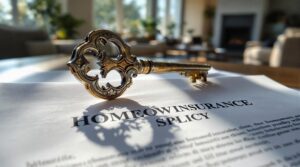Homeowners insurance typically covers fence damage caused by fallen trees when the incident results from covered perils like storms, wind, or lightning. Coverage falls under the "other structures" portion of the policy, usually amounting to 10-20% of dwelling coverage. While policies generally include both repair costs and debris removal, deductibles apply, and actual payouts depend on various factors like depreciation and maintenance history. Understanding specific policy details and coverage limitations helps guarantee proper protection and claim success.
Key Takeaways
- Homeowners insurance typically covers fence damage from fallen trees when caused by natural perils like storms or wind.
- Coverage falls under "other structures" and usually amounts to 10-20% of your dwelling coverage limit.
- Your insurance deductible applies, and the insurer will factor in depreciation when calculating the claim payout.
- The policy covers damage from neighbor's trees, regardless of ownership, unless negligence can be proven.
- Tree removal costs are generally covered only if the tree damaged the fence or blocks access to your property.
Understanding Tree Damage Coverage for Fences
Property owners seeking to understand fence damage coverage under their homeowners insurance policies should be aware of several key factors. Most policies provide coverage when trees fall on fences due to natural perils like storms, wind, lightning, or fire. This coverage typically extends to damage caused by a neighbor's tree, though insurers may pursue recovery from negligent neighbors.
However, significant limitations exist. Coverage for fence repair usually caps at around 10% of the dwelling coverage limit, and deductibles apply to all claims.
Insurance won't cover damage resulting from poor tree maintenance, such as rotting or termite infestation, nor will it cover general wear and tear. While fallen tree removal costs are typically excluded, exceptions exist when trees block driveways or damage structures.
To support claims, homeowners must document damage thoroughly with photos and repair estimates. Understanding these coverage parameters helps property owners make informed decisions about fence maintenance and insurance claims.
The Role of "Other Structures" Coverage
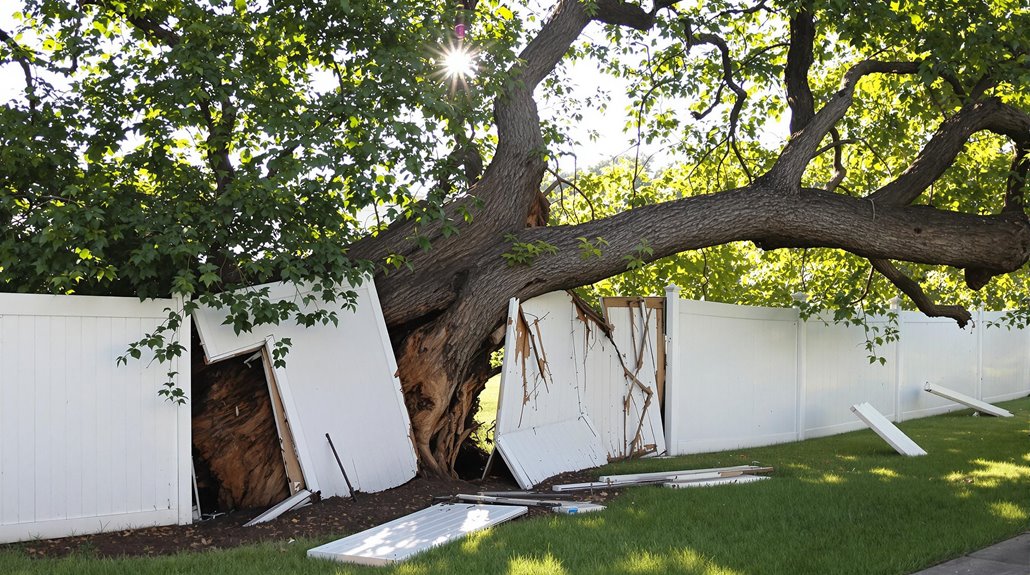
Other Structures coverage typically provides protection at a set percentage of the dwelling coverage amount, usually around 10%.
For a home insured at $300,000, this would translate to $30,000 in coverage for structures like fences and detached garages.
While this standard percentage applies broadly, homeowners should evaluate whether the default coverage limit adequately protects their specific fence and other structure investments.
Coverage Percentage Explained
Standard homeowners insurance policies allocate a portion of coverage specifically for "other structures" on the property, typically providing protection worth 10-20% of the main dwelling's coverage amount. Understanding these coverage nuances is essential when dealing with tree damage to fences, as claim expectations must align with policy limits.
| Coverage Example | $200K Home | $300K Home |
|---|---|---|
| 10% Coverage | $20,000 | $30,000 |
| 20% Coverage | $40,000 | $60,000 |
| Typical Limit | $30,000 | $45,000 |
This percentage-based coverage guarantees adequate protection for structures like fences, detached garages, and sheds. When trees fall and damage these structures, insurance claims are processed within these predetermined limits, considering factors such as depreciation and deductibles.
Policy Limits for Fences
Homeowners insurance policies designate specific coverage limits for fences under the "Other Structures" or "Coverage B" provision, typically allocating 10% of the main dwelling's coverage amount.
While basic coverage may suffice for standard fence maintenance, properties with extensive fencing or higher-value installations may require coverage upgrades to guarantee adequate protection.
Key aspects of fence coverage include:
- Coverage extends to damage from specific perils like fire, wind, and vandalism
- Third-party vehicle damage is typically included
- Natural disasters like floods are generally excluded
For properties with multiple detached structures or premium fencing materials, insurers offer enhanced coverage options up to 30% of the dwelling limit.
Understanding these policy limits is vital when evaluating whether standard coverage adequately protects fence investments or if additional coverage is necessary.
Filing a Claim for Fence Damage
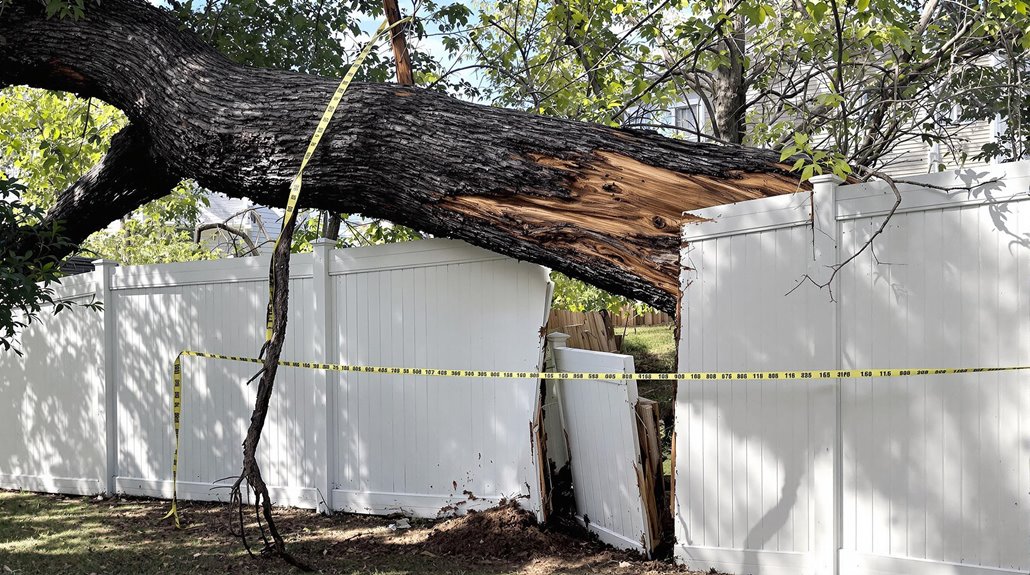
Filing an insurance claim for fence damage requires careful documentation and a systematic approach to guarantee proper coverage. The claim process begins by taking clear photographs of the damage and determining whether the repair costs exceed the policy deductible.
Homeowners should contact their insurance provider to discuss the situation and determine if filing a claim is warranted.
When proceeding with fence repair claims, property owners must complete the necessary claim forms, detailing the damage and its cause.
Working with a claims adjuster is essential, as they will investigate the damage and determine coverage based on the policy terms.
It's vital to maintain all relevant documentation, including original fence installation receipts and repair estimates.
Before filing, homeowners should review their policy's "other structures" coverage to understand specific coverage limits and consider how the claim might affect future premiums.
Proper maintenance records can also help establish that the damage resulted from a covered peril rather than negligence.
When Your Neighbor's Tree Falls
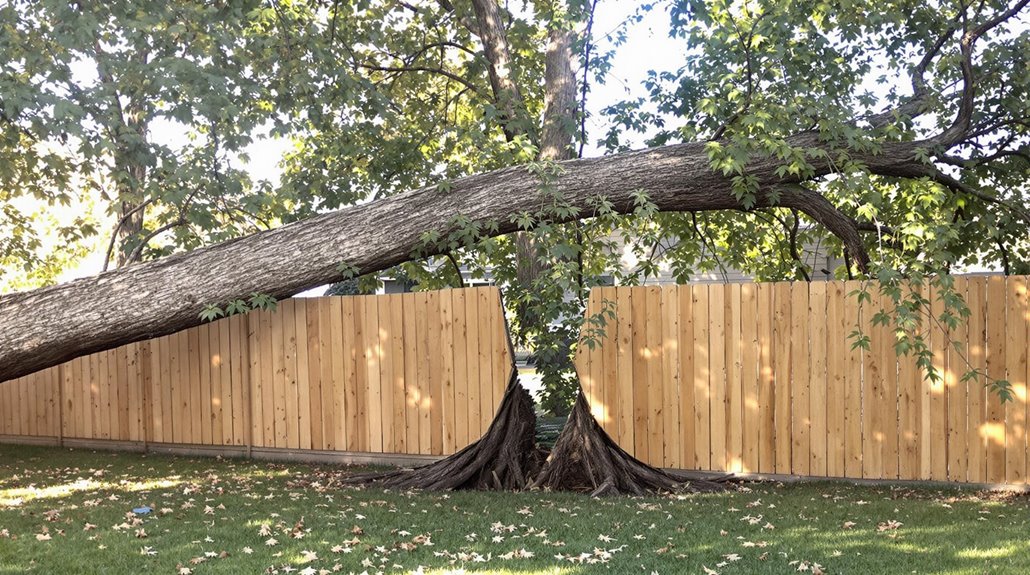
When a neighbor's tree falls and damages a fence, determining insurance coverage responsibility follows specific guidelines.
Typically, the homeowner's insurance policy where the fence is located covers the damage, not the neighbor's policy, if the incident resulted from covered perils such as storms, high winds, or heavy rain. The neighbor is generally not liable for acts of nature causing tree damage.
- Insurance companies may pursue subrogation if neighbor's negligence can be proven
- Coverage includes removal costs up to $500-$1,000 if the tree damaged the fence
- Fences are covered under "other structures" for up to 10% of the house's coverage limit
However, if the tree fell due to poor maintenance or the neighbor's negligence, liability may shift.
In such cases, the insurance company might seek recovery from the neighbor's insurer after paying the claim. Documentation of prior concerns about the tree's condition can support claims of negligence and affect coverage determination.
Insurance Coverage Limits and Deductibles
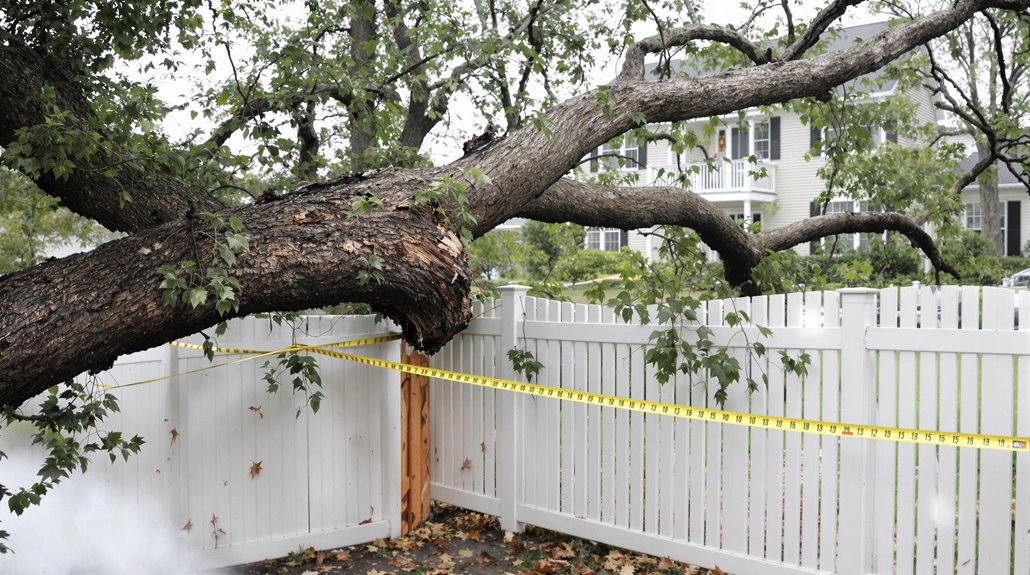
Insurance coverage limits and deductibles play a critical role in determining the actual payout for fence damage caused by fallen trees. Under standard homeowners insurance policies, fences fall under "other structures" coverage, which typically amounts to 10% of the home's total coverage limit.
When initiating the claim process, homeowners must consider their policy's deductible, which will be subtracted from the final settlement amount.
During insurer communication, it's important to understand that coverage extends to both fence repair or replacement and debris removal from the fallen tree.
However, insurance companies factor in depreciation when calculating payouts. While policies generally include tree removal coverage, limits often range between $500 to $1,000, depending on specific policy terms.
Homeowners should carefully evaluate whether filing a claim makes financial sense, considering their deductible amount against the total cost of repairs and potential impact on future premiums.
Documenting Tree and Fence Damage
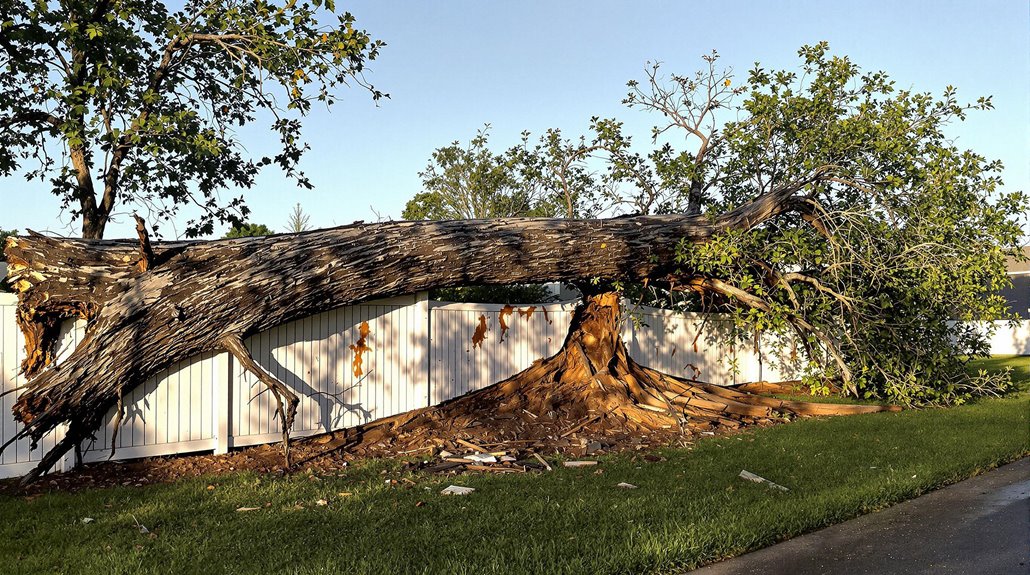
Proper documentation of tree and fence damage serves as a critical foundation for successful insurance claims processing. A thorough tree assessment and detailed documentation of the incident should include the date, time, and weather conditions that led to the tree fall.
Insurance adjusters rely heavily on meticulous documentation to evaluate claims accurately.
Key evidence should be systematically collected and organized:
- Photographs and videos capturing multiple angles of the damaged fence, fallen tree, and any other affected property
- Weather reports, pre-incident tree condition records, and professional evaluations
- Written records of all communications with insurance representatives and contractors
Document evidence must be preserved chronologically, including detailed descriptions of the damage extent and any contributing factors.
Property owners should maintain copies of all submitted materials and follow up regularly with their insurance provider to guarantee proper claim processing.
Professional estimates for repairs should be obtained and included in the documentation package.
Debris Removal and Cleanup Coverage
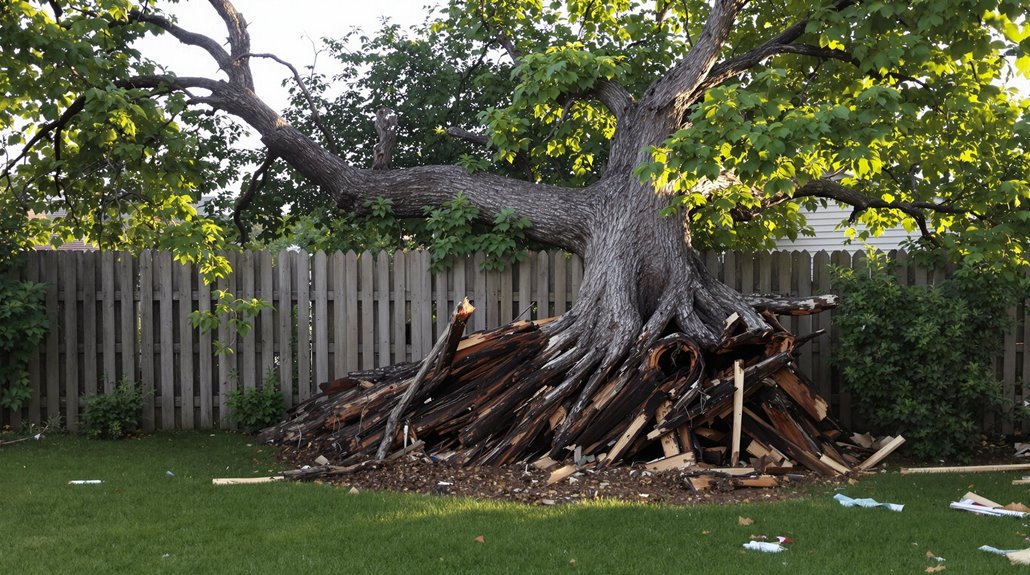
Most homeowners insurance policies include coverage for debris removal when the debris results from a covered peril, though specific terms and limits vary between insurers. The coverage typically applies to cleanup costs associated with removing fallen trees, broken fences, and other damaged materials that require disposal after a covered event.
Insurance providers generally include debris cleanup as part of the "additional coverages" section in their policies. Coverage limitations often specify either a fixed dollar amount or a percentage of the total repair costs.
It is crucial to recognize that insurers only cover debris removal when the debris resulted from a covered peril and caused damage to insured structures. For instance, if a tree falls without damaging property, the removal costs may not be covered.
Homeowners can opt for additional coverage through endorsements if they require protection beyond their standard policy limits, particularly in areas prone to severe weather events.
Determining Liability and Responsibility
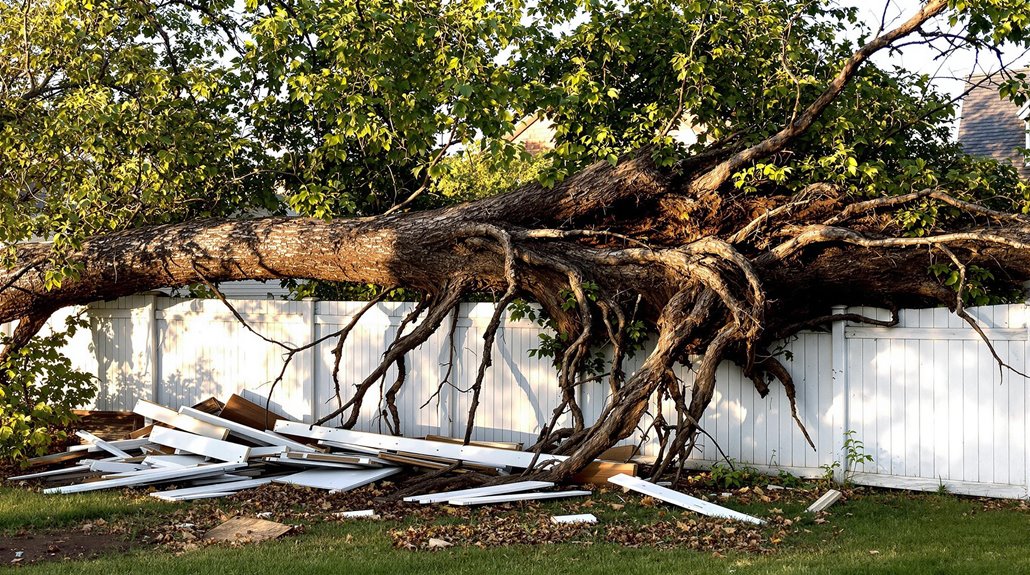
When a tree causes property damage, determining liability involves examining multiple factors, including the tree's condition, ownership, and the circumstances leading to the damage. A thorough liability assessment considers whether the tree owner exercised reasonable care in maintaining the tree and if the damage was preventable.
Key factors that influence liability in tree damage cases include:
- The health and condition of the tree prior to falling
- Whether natural events like storms caused the damage
- Documentation of previous concerns or neighbor disputes about the tree
In cases where a healthy tree falls due to natural events, the property owner who sustained damage typically files a claim with their own insurance.
However, if negligence can be proven – such as failing to remove a visibly diseased tree after receiving complaints – the tree owner may be held liable. Insurance companies may pursue recovery from negligent tree owners after paying claims to their insured parties.
Storm-Related Tree Damage Protection
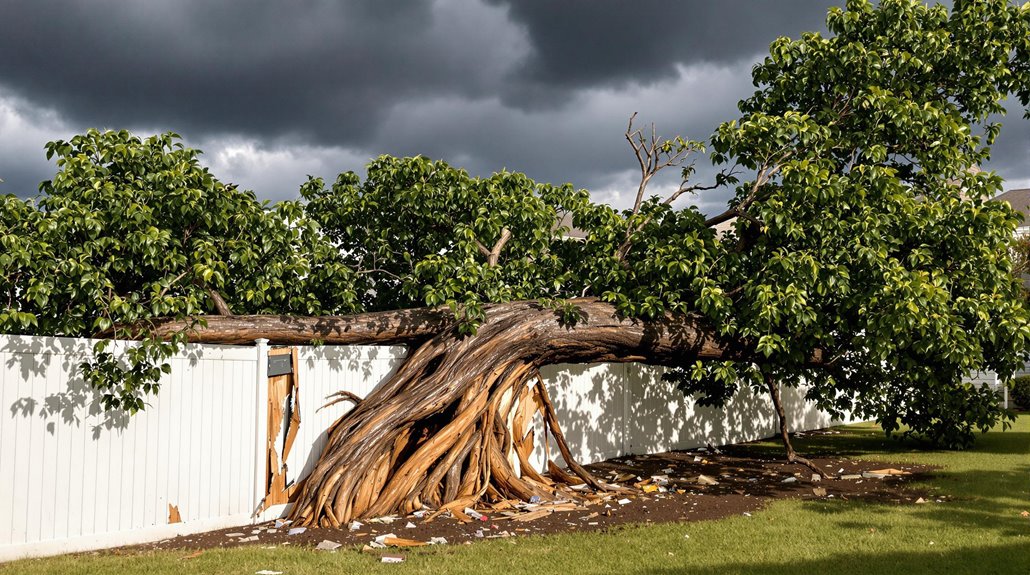
Protecting homes against storm-related tree damage requires an all-encompassing approach that combines preventive maintenance, adequate insurance coverage, and strategic landscaping decisions. Homeowners should prioritize regular tree maintenance to identify and address potential hazards before storms strike.
Insurance policies typically cover storm-related tree damage to fences and structures when caused by covered perils such as windstorms, tornadoes, and lightning. However, coverage limits generally cap tree removal at $500 to $1,000, with total coverage for trees and shrubs often restricted to 5% of the dwelling coverage limit.
For thorough storm protection, homeowners should consider policy enhancements that extend beyond standard coverage.
Regular inspections and proactive tree maintenance are essential elements of storm preparation, as damage resulting from poor maintenance or decay is typically excluded from coverage. This preventive approach not only reduces the risk of storm damage but also helps avoid potential insurance rate increases, which average 9% after filing a claim.
Insurance Recovery and Subrogation Rights
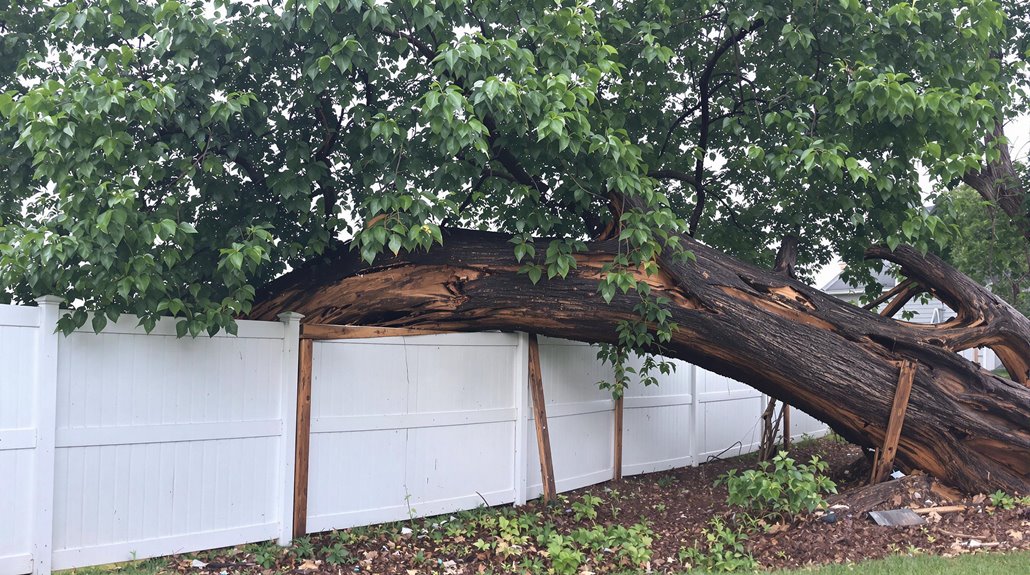
The insurance recovery process for tree-related fence damage involves specific procedures and legal rights that homeowners must understand to maximize their claims.
When filing a claim, documentation of damage and prompt notification to the insurance company are essential steps. The insurer will evaluate coverage based on policy terms and assess whether the damage resulted from a covered peril.
- Claims must include photographic evidence, repair estimates, and documentation of fence installation.
- Coverage typically extends to both tree removal and fence repair costs.
- Deductibles apply, and depreciation may affect settlement amounts.
Through the subrogation process, insurance companies may pursue recovery from negligent parties. If tree negligence by a neighbor contributed to the damage, such as failing to maintain diseased trees, the insurer can seek compensation from the responsible party or their insurance provider.
Successful subrogation often results in reimbursement of the homeowner's deductible, making it a valuable aspect of the claims process.
Frequently Asked Questions
Will Insurance Cover Fence Damage From a Tree That Fell During Landscaping?
Homeowners insurance typically won't cover fence damage from trees falling during landscaping activities. Coverage may apply through landscaping liability insurance if proper tree maintenance protocols weren't followed during the work.
Does Insurance Cover Preventive Tree Removal if It Threatens My Fence?
Homeowners insurance generally does not cover preventive tree removal, as it's considered routine preventive maintenance. Tree health issues and potential threats to structures fall under the homeowner's regular maintenance responsibilities.
Can I Choose My Own Contractor for Fence Repairs After Tree Damage?
Verily, homeowners can select their own contractor for fence repairs, though insurance companies may require approval. The repair process should include obtaining multiple estimates and confirming contractor licensing requirements.
Are Decorative or Ornamental Fence Elements Covered at the Same Rate?
Decorative fence coverage typically falls under "other structures" with standard 10% policy limits. Insurance companies evaluate ornamental element valuation based on material costs, craftsmanship, and depreciation when processing claims.
Will Insurance Cover Temporary Fencing While Waiting for Permanent Repairs?
Insurance policies typically cover temporary repair costs, including temporary fencing, while awaiting permanent repairs. Documentation and prompt filing through the insurance claim process are essential for reimbursement coverage.
Final Thoughts
Studies show that approximately 40% of homeowners insurance claims involving fallen trees result in fence damage. When a tree falls on a fence, coverage typically exists under the "other structures" portion of a standard homeowners policy, usually at 10% of the dwelling coverage limit. Understanding policy details, documenting damage properly, and determining liability remain essential steps in successfully managing tree-related fence damage claims.
When dealing with property damage claims related to fallen trees or any other homeowners insurance matters, both insurance industry insiders and legal experts strongly advise consulting with a qualified state-licensed public adjuster. Public adjusters work exclusively for policyholders, not insurance companies, serving as dedicated advocates throughout the claims process. These state-licensed professionals help property owners navigate complex insurance policies, identify hidden damages often unknown to policyholders, thoroughly document losses, and negotiate with insurance companies to ensure fair settlements.
A public adjuster's expertise can prove invaluable by maximizing claim payouts, expediting the claims process, and reducing the stress of dealing with insurance companies. Policyholders interested in discussing their property damage or loss claims can request a no-obligation free consultation with a Public Claims Adjusters Network (PCAN) member public adjuster through our contact page.
